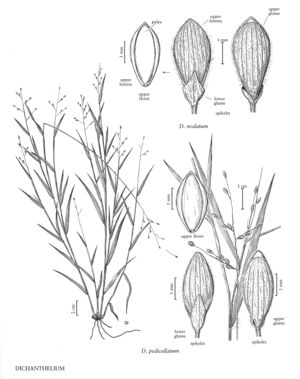Dichanthelium nodatum
Plants usually cespitose, rarely rhizomatous. Basal rosettes absent. Culms 20-65 cm, decumbent to ascending even in spring, with hard, cormlike bases; nodes puberulent to sparsely pubescent; internodes scabrous-puberulent to papillose-hirsute; fall phase with geniculate to decumbent culms, developing divaricate branches from the midculm nodes before the primary panicles mature. Cauline leaves 8-14; sheaths not overlapping, puberulent to papillose-hirsute, margins ciliate; ligules 0.1-1 mm, of hairs; blades 3-9 cm long, 4-8 mm wide, thick, firm, puberulent, sides parallel above the rounded to truncate bases, margins with papillose-based cilia. Primary panicles 3-13 cm long, 2-8 cm wide, exserted; branches ascending to divaricate at maturity; pedicels appressed. Spikelets 3.4-4.4 mm long, 1.3-1.6 mm wide, narrowly obovoid-obpyriform, finely pubescent, hairs papillose-based, bases long, narrow. Lower glumes 1.5-2 mm, attached about 0.2 mm below the upper glumes, partly or completely encircling the pedicels; upper glumes about 0.3 mm shorter than the upper florets, purplish at the bases; lower florets sterile; upper florets with pointed, puberulent apices. 2n = 18 (J. Wipff, pers. comm., 2001).
Discussion
Dichanthelium nodatum grows in oak savannahs near the Gulf coast from Texas to northeastern Mexico. The primary panicles are produced from April into June (sometimes late August to November) and are at least partly open-pollinated; the secondary panicles are produced from May into fall and are at least partly cleistogamous.
Selected References
None.
Lower Taxa
No values specified."usually distinctly longer and narrower" is not a number."decumbent" is not a number.
